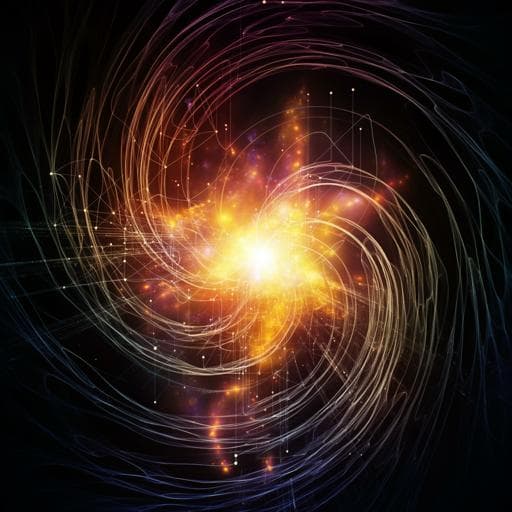
Physics
Indistinguishable photons from an artificial atom in silicon photonics
L. Komza, P. Samutpraphoot, et al.
Discover the groundbreaking work by Lukasz Komza and colleagues, showcasing an indistinguishable photon source in silicon photonics. This innovative G center technology generates high-purity telecom-band single photons, paving the way for advanced photonic quantum networks and processors.
~3 min • Beginner • English
Introduction
Silicon photonics provides a mature, low-loss, and reconfigurable platform for integrated quantum technologies, promising scalability by leveraging semiconductor manufacturing. However, scalable photonic quantum computing in silicon is challenged by the absence of deterministic quantum light sources, photon-photon gates, and quantum memories, leading to large overheads in fault-tolerant architectures. Carefully controlled quantum emitters integrated into photonic circuits could enable hardware-efficient universal photonic computation and time-multiplexed quantum networking. Despite progress, an atomic source of indistinguishable photons in silicon had been missing. This work addresses that gap by demonstrating telecom-band indistinguishable photon generation from a single artificial atom (a G center) embedded in a silicon waveguide.
Literature Review
Methodology
Device and emitter: A single G center (a complex defect in silicon comprising two substitutional carbon atoms and an interstitial silicon) is created inside a silicon photonic waveguide via ion implantation followed by high-temperature annealing. The platform uses a 1 cm × 1 cm chip diced from a 200 mm high-resistivity SOI wafer (float-zone, >30000 Ω·cm, 2 mm SOI) prepared via SmartCut. Carbon implantation and annealing are performed prior to lithography.
Photonic structure fabrication: An HSQ resist etch mask is patterned by electron-beam lithography and developed in NaOH/H2O. Etching of silicon uses Cl2/HBr chemistry. Approximately 3 μm of silicon dioxide is deposited by PECVD as cladding. A photonic crystal Bragg reflector is integrated to provide near-unity reflection for TE polarization over a ~150 nm bandwidth centered at ~1330 nm (band biased toward wavelengths longer than the center’s ZPL to include phonon sideband). The waveguide, fabricated along the (100) axis, has a width of 300 nm (optimized for high field at the center to enhance emitter coupling) and is adiabatically tapered to 130 nm over 50 μm for efficient coupling to a 2.5 μm lensed fiber. AFM characterization confirms a lattice constant of 370 nm and hole placement metrics.
Optical setup and excitation: Above-bandgap excitation is provided (e.g., 635 nm CW for scanning/PL imaging; 705 nm pulsed for lifetime). Emission from the G center zero-phonon line (ZPL) near 1.28–1.33 μm is collected into a lensed single-mode fiber from the waveguide facet. A bandpass filter (1280 ± 6 nm) isolates the ZPL. A tunable Fabry–Perot (FP) cavity analyzes emission spectra. Time-resolved single-photon detection and intensity correlation measurements are performed to extract g^(2)(τ) and lifetime.
Emitter localization and saturation: The device is scanned with a focused 635 nm beam while monitoring waveguide-coupled PL through the lensed fiber to locate isolated emitters. A single bright G center is identified with detected ZPL photon rate ~18 kHz through the bandpass filter. Power dependence of the PL rate R_ph versus excitation power P is measured and fit with a model incorporating a two-level response plus weak linear background, yielding saturation parameters.
Lifetime and quantum efficiency: Using a 705 nm pulsed laser, time-correlated single-photon counting yields the excited-state lifetime τ_G. Setup losses are calibrated to estimate ZPL branching and radiative lifetime τ_R, enabling inference of branching factors.
Spectral measurements: The ZPL spectrum is measured with an FP cavity. The measured spectrum is deconvolved with the FP instrument response to estimate the emitter linewidth. Multiple measurements provide the total observed linewidth and the deconvolved G center linewidth.
Second-order correlations: Hanbury Brown–Twiss measurements of g^(2)(τ) under pulsed and CW excitations quantify single-photon purity and temporal stability. Error bars reflect Poissonian counting statistics, and reported parameters arise from fits to the correlation histograms.
Two-photon indistinguishability (HOM): Successive photons from the G center are interfered using a fiber-based time-delayed Mach–Zehnder interferometer with an additional path delay Δτ = 25 ns. A polarization controller sets relative photon polarizations to probe indistinguishable (parallel) and distinguishable (orthogonal) cases. The resulting g^(2)(τ) at the interferometer outputs is recorded, revealing a quantum interference dip at zero delay for indistinguishable photons.
Key Findings
- Single artificial atom source in silicon waveguide: An isolated G center embedded in a silicon photonic waveguide generates telecom-band single photons that are collected efficiently via a lensed fiber.
- Brightness and saturation: Detected ZPL photon rate ~18 kHz with a 1280 ± 6 nm bandpass. Power-dependent PL fits yield saturation count rate R_max ≈ 35 ksps and saturation power P_act ≈ 2.44 μW.
- Lifetime and emission probability: Measured PL lifetime τ_G = 4.61 ns under 705 nm pulsed excitation. Per-pulse ZPL photon detection probability ≈ 0.40 × 10^-3. Accounting for setup losses and a ZPL branching ratio ≈ 0.18, the radiative lifetime is estimated as τ_R ≈ 1.1 ns, implying β = τ_G/τ_R ≈ 3.4.
- Spectral properties: FP-cavity spectroscopy gives measured emission widths on the order of a few GHz. One dataset shows measured width 6.20 GHz with FP linewidth 3.40 GHz, yielding a deconvolved G center linewidth ≈ 2.841 GHz. Another measurement indicates total linewidth k/2π ≈ 3.6 GHz and deconvolved emitter linewidth Γ/2π ≈ 2.0 ± 0.5 GHz, consistent with narrow single-photon emission.
- Single-photon purity: Second-order intensity correlations show g^(2)(0) = 0.152 (< 0.4), confirming high-purity single-photon emission. Long-term g^(2)(τ) under CW excitation shows stability without excess intensity fluctuations for τ ≥ 50 ns, with a shorter-timescale feature attributed to a metastable state.
- Indistinguishability: Time-delayed HOM interference of successive photons (Δτ = 25 ns) exhibits a quantum interference dip in g^(2)(τ) at short delays for parallel (indistinguishable) polarizations, while orthogonal polarizations serve as the distinguishable reference, demonstrating photon indistinguishability from a G center in a silicon waveguide.
Discussion
The work demonstrates that an artificial atom (G center) integrated in a silicon waveguide can serve as a source of high-purity, indistinguishable single photons at telecom wavelengths. The observed g^(2)(0) well below 0.5 and the HOM interference dip under parallel polarization validate both single-photon purity and indistinguishability, addressing a central challenge in silicon photonics—lack of atomic-grade photon sources. The GHz-scale ZPL linewidths, ns-scale excited-state lifetime, and stable intensity correlations indicate suitability for time-resolved quantum photonic protocols.
The platform’s compatibility with silicon photonics suggests straightforward integration with low-loss, reconfigurable circuits. The discussion outlines pathways to enhance performance using cavity QED: by engineering photonic crystal or ring cavities to tune the external decay rate (Purcell regime) for high efficiency and indistinguishability, or by pushing into the strong-coupling regime. With improved material quality and environmental isolation to suppress spectral diffusion, projected parameters {g, κ, γ} ≈ {1.3, 0.25, 0.2} GHz could yield cooperativity C ≈ 4g/κ ≈ 100, enabling deterministic light–matter interactions and high-fidelity spin–photon gates. Such advances would underpin scalable photonic quantum processors and quantum repeaters on a silicon platform.
Conclusion
This study reports the first demonstration of indistinguishable photon generation from a single artificial atom (G center) embedded in a silicon photonic waveguide. The device exhibits high single-photon purity (g^(2)(0) ≈ 0.152), narrow ZPL linewidths after instrument deconvolution (≈ 2–3 GHz), and a clear HOM interference signature of indistinguishability for successive photons. These results establish a key building block for silicon-based photonic quantum networks and processors.
Future research should focus on cavity integration to boost emission rate, efficiency, and indistinguishability via Purcell enhancement, and on materials/device engineering to reduce spectral diffusion. Incorporating spin-bearing silicon artificial atoms could enable high-fidelity spin–photon interfaces, paving the way for scalable quantum processors and repeaters realized with advanced silicon manufacturing and heterogeneous integration.
Limitations
- The reported g^(2)(0) is limited by factors including the ratio of repetition period to excited-state lifetime (exponential tail), imperfect extinction in pulsed laser downsampling, and detector dark counts.
- The per-pulse detected ZPL probability (~4×10^-4) and ZPL branching (~0.18) indicate significant losses and limited ZPL emission fraction, suggesting room for efficiency improvement.
- Spectral diffusion and a metastable state contribute to short-timescale intensity dynamics; environmental engineering and isotopic purification may further stabilize the emission.
- No explicit HOM visibility value is reported; quantitative indistinguishability metrics may require higher signal-to-noise and cavity-enhanced collection.
- Discrepancies in measured linewidths across setups highlight sensitivity to instrument response and emitter environment; cavity integration and improved spectroscopy could resolve this.
Related Publications
Explore these studies to deepen your understanding of the subject.







